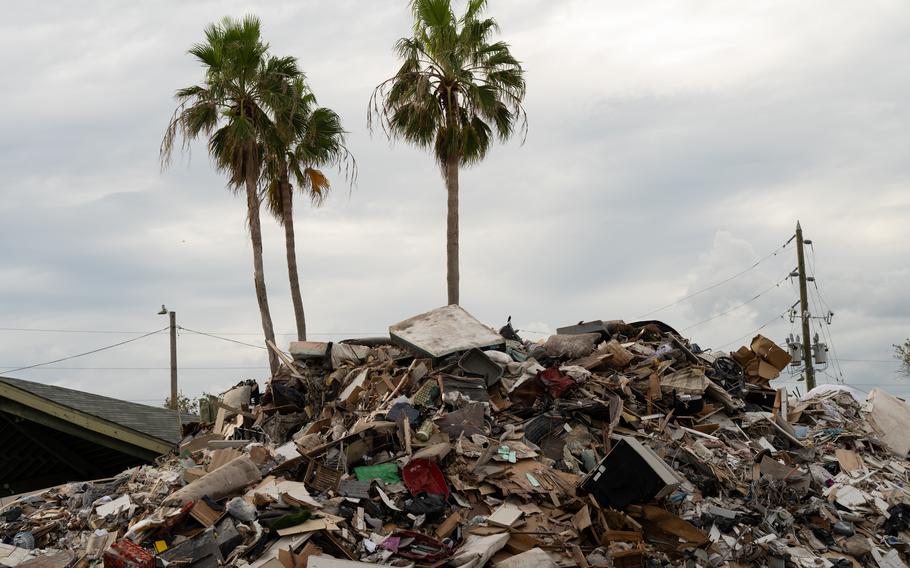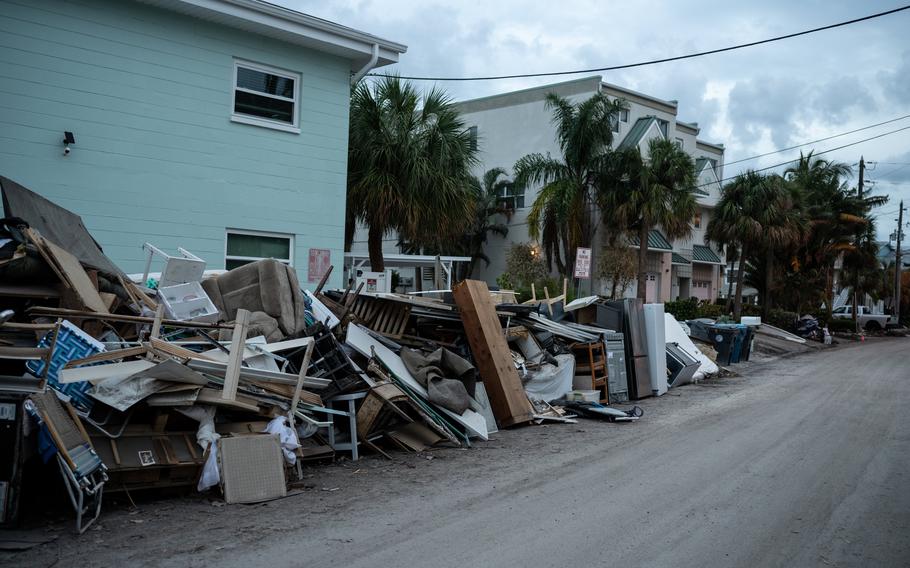
The piles of appliances and trash left behind by Hurricane Helene, like this one in Treasure Island, Fla., could be a major hazard when Hurricane Milton hits. (Thomas Simonetti )
TREASURE ISLAND, Fla. — Eric Von Stein spent days picking up the debris that Hurricane Helene’s storm surge dumped into his yard — toys from his neighbor’s playroom, old furniture from another neighbor’s garage and his own spare refrigerator.
Nearly two weeks later, it all sits in a giant 10-foot-high pile near his home. Similar stacks of ruined kitchen stoves, shards of wood and broken cabinets line many streets in the Tampa Bay area, the detritus of a storm residents were only starting to recover from.
Now county and state officials in Florida need to rush to pick it all up before another strong hurricane is expected to hit the region and potentially make all that debris a major hazard.
“This is a 24/7 moment for this debris removal,” Gov. Ron DeSantis (R) said Sunday. “You have a storm and then have one less than two weeks later — two majors back to back — that is not something that is easy. That creates a lot of challenges. And so what we have to do is just do it round-the-clock, until it’s no longer safe to do it.”
DeSantis said the state has deployed 800 National Guard members to impacted areas and is in the process of deploying thousands more — many of whom he had sent to North Carolina to help recovery efforts there. Waste and landfill sites have been ordered to remain open through the night. He implored local county officials to work nonstop until Hurricane Milton hits, describing it as a “debris removal mission.”
Many residents in the hardest-hit areas of Pinellas County, which includes the St. Petersburg area, fear the cleanup won’t happen in time.
“Normally what you do in a situation like this is you’d get everything secured that could blow away and become a projectile and hurt someone,” Von Stein said. “But now there’s just so much stuff on the curb, there’s not enough time to do that.”
Computer models forecast Milton to generally follow a course considerably farther south than Helene, which should spare the Southern Appalachians from serious impacts. Little or no rain or wind from the storm should reach the western Carolinas. However, Milton could seriously affect some parts of Florida that are still recovering from Helene.
The core of the storm will probably remain south of the Big Bend — where Helene came ashore — but Milton could strike more populous areas farther down the coast, including Tampa and Fort Myers. Some models show Milton making a direct hit on the Tampa Bay area, which would bring a devastating storm surge, perhaps two times larger than the one generated by Helene. The exact track forecast is still uncertain.
Pinellas County is 100 miles south of where Hurricane Helene made landfall, but it was hit with historic surge from the massive storm. At least 12 deaths were reported there, the most of any county in Florida. Many residents did not heed evacuation orders there. The water wrecked homes and tore through the bottom floors of buildings, disgorging the contents out into the street.
Pinellas County Public Works Director Kelli Hammer Levy told residents last week that the county was doing what it could to pick up debris but that it was a daunting task.
She compared Helene with Hurricane Irma in 2017, saying Helene’s debris pickup was far more challenging. Irma thrashed most of the state with high winds but didn’t cause historic storm surge in as many places as Helene. Irma produced about 600,000 cubic yards of “primarily vegetative debris.”

The piles of appliances and trash left behind in Treasure Island, Fla., by Hurricane Helene could be a major hazard when Hurricane Milton hits. (Thomas Simonetti for The Washington Post)
Helene, by contrast, left much more behind.
“We’re dealing with a flooding event that is generating several million cubic yards of debris that is primarily construction and demolition and white goods,” she said, referring to items such as appliances. “It’s a very different challenge than we had in Irma.”
On Sunday, Pinellas County, under the direction of the Florida Division of Emergency Management, opened the main gate to its solid-waste disposal facility to anyone who could get trash to the site. The county’s website said it would remain open until operations are shut down during Milton.
Treasure Island, a community located along a barrier island in Pinellas County, sustained some of the worst damage from Helene in Florida. The city’s mayor, Tyler Payne, drove a golf cart around the area this weekend, talking with residents and surveying the cleanup.
“Things were starting to look better, even if just a little bit,” he said. “We did not need another hurricane to come our way.”
Mike Tutko was among those trying to clean up the debris from his condo parking lot while at the same time keeping an eye on the forecast for Milton. He didn’t evacuate for Helene, but he said he was nervous about all the debris still waiting for pickup. This time, he and his wife will head inland.
“All this debris piled up, those things will become projectiles with 120-mile-an-hour winds,” Tutko, 83, said.
Von Stein was similarly weighing his options on Sunday. He planned do what little was in his control - turning off the gas, the breakers in his garage and locking the door - before heading out of town. He also planned to secure anything in his yard that might blow away.
But he worried about the towering stacks of debris around his neighborhood and the heavier items in his own yard — such as concrete slabs from a neighbor’s patio — that he hasn’t been able to remove.
“There’s just so much stuff,” he said. “I mean, I can’t get it out on the curb. There’s no way to physically do that.”